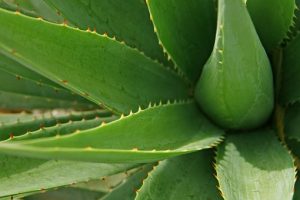By Charmaine Peters

It’s officially summertime! As temperatures rise, caring for plants to thrive in summer weather can be challenging, especially in South Florida, where it’s hot and humid. Many plants wilt or suffer from heat stress if they aren’t in the right growing conditions or given proper care.
If you’re looking for a plant you can grow at home that loves the sun and grows well in a warmer climate, aloe vera is your best bet. It’s one of the best low-maintenance indoor plants, suitable for gardeners of any skill level. It’s a hardy succulent with thick leaves filled with a gel that’s 99% water and packed with health and beauty benefits. Aloe vera gel can be your go-to natural solution to soothe sunburns and keep your skin hydrated during the summer.
To have a fresh supply of aloe vera in summer – or all year round – follow this guide on how you can grow your own wonder plant:
How to Get Aloe Vera Offsets
It’s very common to propagate aloe plants from offsets, also known as “pups.” These are small offshoots that grow from the base of a mature aloe vera plant and often have their own root system. To get your own aloe vera offsets, do this:
- Select the source. Look for mature aloe vera plants that have been growing for a few years. These plants are more likely to produce offsets.
- Inspect the base: Check the base of the aloe vera plant for small pups. These are usually clustered around the main stem and can vary in size.
- Remove an offset: Gently dig around the base of the offset to expose its roots. Then, using your knife or shears, cut the offset away from the main plant. Make sure that it has some roots attached.
- Allow to dry: Let the offset sit in a warm, dry, location for a day or two to allow the cut end to callous over. This helps prevent rotting when the offset is planted.
How to Plant Aloe Vera Offsets
- Prepare the pot and soil. Start by choosing a well-draining pot, like a terra cotta pot or container with drainage holes to prevent waterlogging. Make sure the pot is slightly larger than the offset to provide room for root growth. Aloe vera prefers a sandy or cactus potting mix.
- Plant the offset. After allowing the offset to dry, plant it at the same depth as it was growing before, and lightly pack the soil around it.
- Allow a recovery period. Do not water after planting your aloe vera, instead, wait for at least a week. This will lower the risk of root rot and allow the plant to grow new roots. Leave it in a warm place that receives bright but indirect light.
- Water and fertilize sparingly. Overwatering can lead to root rot, so it’s essential to let the soil dry between waterings. The plant needs little to no fertilization. Apply balanced fertilizer diluted to half its strength only during the growing season to encourage healthy growth.
- Monitor for signs of stress. Keep an eye on the newly planted offset for any signs of stress, such as wilting or discoloration. Keep it away from direct sunlight until the plant establishes itself. Use clean scissors to prune brown or damaged leaves to encourage new growth. You can also remove offsets that appear at the base of the plant to prevent overcrowding.
With its resilience to summer conditions and its benefits to your summer plans, the aloe vera plant is a perfect addition to your home garden this season. Just as it hydrates the skin, let it remind you to keep yourself hydrated and drink plenty of water – and ensure your plants do too. Check out these five common watering mistakes you might be making in your garden to ensure you avoid them, so your plants thrive all season long! Have a green and vibrant summer!

